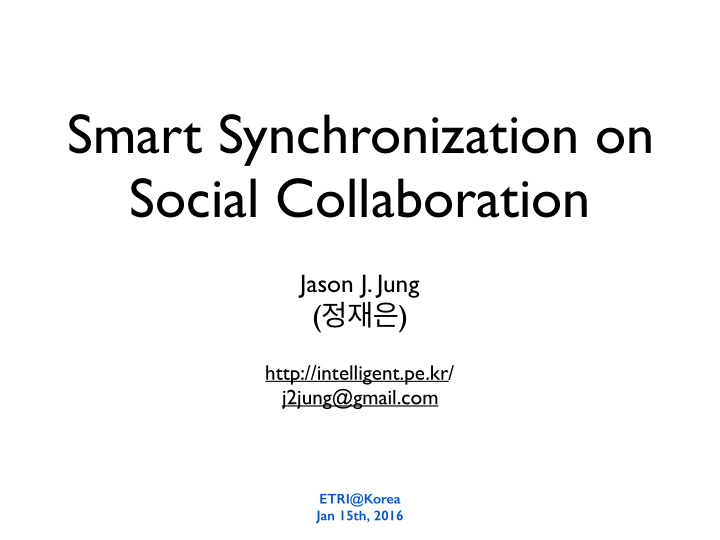



Smart Synchronization on Social Collaboration Jason J. Jung ( 정재은 ) http://intelligent.pe.kr/ j2jung@gmail.com ETRI@Korea Jan 15th, 2016
Background • Large scale organization (a number of users & a large amount of data)
Collaboration tools in enterprise computing environment
Agenda • Contextual Synchronization • Social contextualization • Social media communication • Examples • Conclusion
Agenda • Contextual Synchronization • Social contextualization • Social media communication • Examples • Conclusion
What is contextual synchronization?
Synchronization • happening, existing, or arising at precisely the same time • recurring or operating at exactly the same periods • [Merriam-Webster]
Synchronization
Synchronization • (cont.) Data synchronization refers to the idea of keeping multiple copies of a dataset in coherence with one another, or to maintain data integrity. Process synchronization primitives are commonly used to implement data synchronization. http:// en.wikipedia.org/wiki/ Synchronization_(computer_science)
Synchronization • A set of communication actions in proper order 1. Send(a, b) 2. Ack(b, a) 3. Send(b, c) 4. Ack(c, b), Ack(c, a) ....
Contextual Synchronization • Contextual synchronization refers to the idea of keeping multiple USERS in coherence with one another, or to maintain data integrity by considering their contexts .
Information Propagation
Behavior Mimicry
Tagoole • Understanding various features of information propagation • How quickly a certain information is propagated? • How widely .... ? Xuan Hau Pham, Jason J. Jung, Dosam Hwang, "Beating social pulse: Understanding information propagation via online social • Why .... ? tagging systems," Journal of Universal Computer Science, Vol. 18, No. 8, pp. 1022-1031, 2012
Building Social Pulse
Folksonomy Temporal Folksonomy
T+Folksonomy • Temporal distribution of frequencies • Inducibility, a relationship between two arbitrary tags
Arab Spring 2011 Egyptian revolution
TweetPulse
Agenda • Contextual Synchronization • Social contextualization • Social media communication • Examples • Conclusion
Context-aware services • Location • Time • Any other context?
Social networks (2010)
Mark Zuckerberg
Flickr FaceBook Twitter Twitter Twitter FaceBook FaceBook Mark Zuckerberg
With a number of online social media, our social networks are distributed
Ego-centric Social Network (e-SN) • Social networks are distributed in many different applications, e.g., Facebook and Twitter. • Thus, the partial social networks have to be integrated to build an ego-centric social network.
Why e-SN? • Personalized filtering
Only from my neighbors
Social contextualization • Context fusion • We need to collect all possible information (e.g., resources and knowledge) from our neighbors. • Fusing contextual information around target users
Contextualization • To provide context-aware services, e-SN should be contextualized with • location • time • context of my neighbors • Need to consider to exploit the planner module
Scenario on Context Fusion • It is my wife’s birthday, tomorrow. • I am in “Puerta del Sol” for a technical meeting.
Current Location “Puerta del Sol” My Wife’s Birthday My wife’s favorite movies Tomorrow Recommendation Promotion news from “El Corte Inglés” https://twitter.com/elcorteingles Restaurants and Cafes near Current location
Reality mining for TelCon • Building a social network by mobile phone usage patterns • How ofter (or how long) has Ua called Ub? • Inferring semantics of each social links between users • What is the relationship between Ua and Ub? Jason J. Jung, Hojin Lee, Kwang Sun Choi, "Contextualized Recommendation Based on Reality Mining from Mobile Subscribers," Cybernetics and Systems, Vol. 40, No. 2, pp. 160-175, 2009.
Agenda • Contextual Synchronization • Social contextualization • Social media communication • Examples • Conclusion
Social media communication • A number of communication media among users • E-mail, Telephone, SMS, Video conferencing, Instant messaging, and so on. Chulmo Koo, Yulia Wati, Jason J. Jung, "Examination of how Social Aspects Moderate the Relationship between Task Characteristics and Usage of Social Communications Technologies (SCTs) in Organizations," International Journal of Information Management, Vol. 31, No. 5, pp. 445-459, 2011.
Question: How (and Why) people choose the SCTs?
Social affinities (context) • Vertical vs. Horizontal • e.g., “Ask your boss to answer.” and “Ask your students to come” • Also, cultural differences
Task characteristics • Urgency (e.g., “Find the answer right now”) • Complexity (e.g., “Explain what is the capital of Portugal” and “Tell me what is contextual synchronization”) • Multiplicity (e.g., 1:1, 1:N, and M:N communications)
Media richness • Need to weigh a SCT • Weight(email) > Weight(SMS)
Example Jason J. Jung, "Boosting Social Collaborations Based on Contextual Synchronization: An Empirical Study," Expert Systems with Applications, Vol. 38, No. 5, pp. 4809-4815, 2011.
Sara Sidle CSI Level 3 Nick Stokes Warrick Brown Greg Sanders CSI Level 3 CSI Level 3 Capt. Jim Brass CSI Level 2 Hair and fiber analysis LVPD Homicide Gil Grissom Detective Al Robbins CSI Night-Shift Catherine Willows Chief Medical Supervisor CSI Asst. Night-Shift Examiner Supervisor
Vision Cross-media Communication Ask @Gil and @Robbin who the murderer is.
Wrap-up • The main research question is • “How to support users to efficiently collaborate with each other?” • Ontologies? Linked Data? • Any questions & comments
Recommend
More recommend